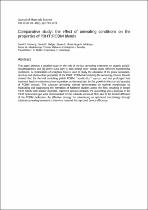 ResearchSpace
ResearchSpace
Comparative study: the effect of annealing conditions on the properties of P3HT:PCBM blends
JavaScript is disabled for your browser. Some features of this site may not work without it.
- ResearchSpace
- →
- Research Publications/Outputs
- →
- Journal Articles
- →
- View Item
| dc.contributor.author |
Motaung, DE

|
|
| dc.contributor.author |
Malgas, GF

|
|
| dc.contributor.author |
Nkosi, SS

|
|
| dc.contributor.author |
Mhlongo, Gugu H

|
|
| dc.contributor.author |
Mwakikunga, Bonex W

|
|
| dc.contributor.author |
Malwela, T

|
|
| dc.contributor.author |
Arendse, CJ

|
|
| dc.contributor.author |
Muller, TFG

|
|
| dc.contributor.author |
Cummings, FR

|
|
| dc.date.accessioned | 2013-11-25T12:57:03Z | |
| dc.date.available | 2013-11-25T12:57:03Z | |
| dc.date.issued | 2013-02 | |
| dc.identifier.citation | Motaung, D.E, Malgas, G.F, Nkosi, S.S, Mhlongo, G.H, Mwakikunga, B.W, Malwela, T, Arendse, C.J, Muller, T.F.G and Cummings, F.R. 2013. Comparative study: the effect of annealing conditions on the properties of P3HT: PCBM blends. Journal of Materials Science, vol. 48(4), pp 1763-1778 | en_US |
| dc.identifier.issn | 0022-2461 | |
| dc.identifier.uri | http://link.springer.com/article/10.1007%2Fs10853-012-6937-6 | |
| dc.identifier.uri | http://hdl.handle.net/10204/7094 | |
| dc.description | Copyright: 2013 Springer. This is an ABSTRACT ONLY. The definitive version is published in Journal of Materials Science, vol. 48(4), pp 1763-1778 | en_US |
| dc.description.abstract | This paper presents a detailed study on the role of various annealing treatments on organic poly(3-hexylthiophene) and [6]-phenyl-C(sub61)-butyric acid methyl ester blends under different experimental conditions. A combination of analytical tools is used to study the alteration of the phase separation, structure and photovoltaic properties of the P3HT:PCBM blend during the annealing process. Results showed that the thermal annealing yields PCBM “needle-like” crystals and that prolonged heat treatment leads to extensive phase separation, as demonstrated by the growth in the size and quantity of PCBM crystals. The substrate annealing method demonstrated an optimal morphology by eradicating and suppressing the formation of fullerene clusters across the film, resulting in longer P3HT fibrils with smaller diameter. Improved optical constants, PL quenching and a decrease in the P3HT optical bad-gap were demonstrated for the substrate annealed films due to the limited diffusion of the PCBM molecules. An effective strategy for determining an optimized morphology through substrate annealing treatment is therefore revealed for improved device efficiency. | en_US |
| dc.language.iso | en | en_US |
| dc.publisher | Springer | en_US |
| dc.relation.ispartofseries | Workflow;11310 | |
| dc.subject | X-ray diffractions | en_US |
| dc.subject | Atomic force microscopy | en_US |
| dc.subject | Polarized optical microscopy | en_US |
| dc.title | Comparative study: the effect of annealing conditions on the properties of P3HT:PCBM blends | en_US |
| dc.type | Article | en_US |
| dc.identifier.apacitation | Motaung, D., Malgas, G., Nkosi, S., Mhlongo, G. H., Mwakikunga, B. W., Malwela, T., ... Cummings, F. (2013). Comparative study: the effect of annealing conditions on the properties of P3HT:PCBM blends. http://hdl.handle.net/10204/7094 | en_ZA |
| dc.identifier.chicagocitation | Motaung, DE, GF Malgas, SS Nkosi, Gugu H Mhlongo, Bonex W Mwakikunga, T Malwela, CJ Arendse, TFG Muller, and FR Cummings "Comparative study: the effect of annealing conditions on the properties of P3HT:PCBM blends." (2013) http://hdl.handle.net/10204/7094 | en_ZA |
| dc.identifier.vancouvercitation | Motaung D, Malgas G, Nkosi S, Mhlongo GH, Mwakikunga BW, Malwela T, et al. Comparative study: the effect of annealing conditions on the properties of P3HT:PCBM blends. 2013; http://hdl.handle.net/10204/7094. | en_ZA |
| dc.identifier.ris | TY - Article AU - Motaung, DE AU - Malgas, GF AU - Nkosi, SS AU - Mhlongo, Gugu H AU - Mwakikunga, Bonex W AU - Malwela, T AU - Arendse, CJ AU - Muller, TFG AU - Cummings, FR AB - This paper presents a detailed study on the role of various annealing treatments on organic poly(3-hexylthiophene) and [6]-phenyl-C(sub61)-butyric acid methyl ester blends under different experimental conditions. A combination of analytical tools is used to study the alteration of the phase separation, structure and photovoltaic properties of the P3HT:PCBM blend during the annealing process. Results showed that the thermal annealing yields PCBM “needle-like” crystals and that prolonged heat treatment leads to extensive phase separation, as demonstrated by the growth in the size and quantity of PCBM crystals. The substrate annealing method demonstrated an optimal morphology by eradicating and suppressing the formation of fullerene clusters across the film, resulting in longer P3HT fibrils with smaller diameter. Improved optical constants, PL quenching and a decrease in the P3HT optical bad-gap were demonstrated for the substrate annealed films due to the limited diffusion of the PCBM molecules. An effective strategy for determining an optimized morphology through substrate annealing treatment is therefore revealed for improved device efficiency. DA - 2013-02 DB - ResearchSpace DP - CSIR KW - X-ray diffractions KW - Atomic force microscopy KW - Polarized optical microscopy LK - https://researchspace.csir.co.za PY - 2013 SM - 0022-2461 T1 - Comparative study: the effect of annealing conditions on the properties of P3HT:PCBM blends TI - Comparative study: the effect of annealing conditions on the properties of P3HT:PCBM blends UR - http://hdl.handle.net/10204/7094 ER - | en_ZA |





